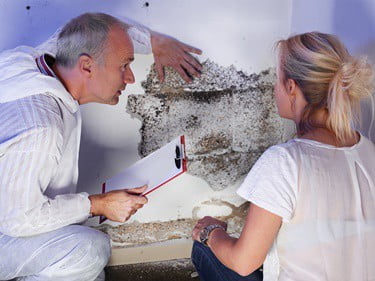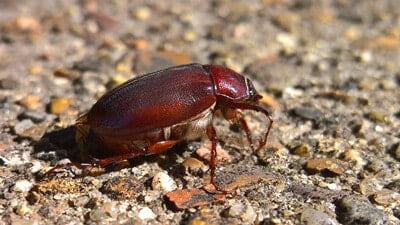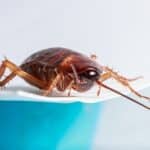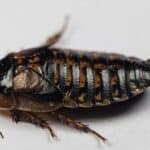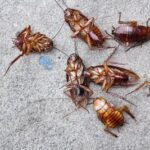Whether you live in a condo, a townhouse, or a city apartment, the mere thought of dealing with a cockroach infestation can be terrifying. These annoying, disease-spreading pests reproduce quickly, and they build their colonies in the most unimaginable places, including cracks and crevices in the walls.
You may hear cockroaches in the walls at night when they’re most active. Most house roaches don’t make noise, but you may hear a colony shuffling through in large numbers. Noises get louder with a heavy infestation.
Wild cockroaches only make chirping sounds when they’re courting, mating, or need to defend themselves. In this case, the male cockroach rubs his pronotum against his costal veins to produce a hissing sound. This attracts female cockroaches or wades off other males. If the noises intensify, you have a severe roach infestation.
Can Cockroaches Live in Walls?
Cockroaches are likely to live inside the walls of your house if the area offers them darkness and humidity. Likewise, cockroaches normally reside near their main sources of food. So, they’ll always seek out cracks, crevices, and other structural flaws throughout your home.
Because of their exoskeletons, cockroaches are extremely flexible. They are capable of entering through the tiniest spaces with relative ease. Considering this, cockroaches can hide and live in cracks and crevices in your wall without much difficulty. Here, they can establish their colonies quickly and find food and water easily.
If left unchecked, the cockroaches can reproduce fast, leading to a severe infestation. Vacuum out all cracks, interior walls, crevices, and baseboards along walls. This will remove nymphs, droppings, dead cockroaches, shed skins, and egg sacks (ootheca).
You can also apply diatomaceous earth, boric acid, or residual spray to cracks and crevices. This will kill live cockroaches and prevent reinfestations once the cockroaches are gone.
Do Cockroaches Make Noise in Walls?
The cockroaches that infest homes don’t make noise. For example, German cockroaches and American cockroaches aren’t able to make chirping or clicking sounds. For this reason, if you hear cockroaches in your walls, you have a large infestation. The only sounds they produce are:
- Fluttering sounds as many species have wings and some can fly
- Cockroaches bumping into objects or scraping across surfaces
- Lots of cockroaches crawling on or around each other
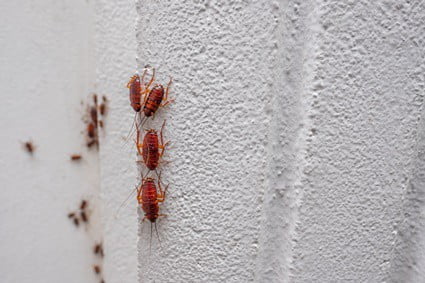
Do Cockroaches Nest in Walls?
Cockroaches can nest in the walls of your house, especially if you have a heavy infestation. That’s because a cockroach’s nest is not a nest in the traditional sense. It’s a place where cockroaches congregate in large numbers. They may gather in your walls if the space is favorable (quiet, dark, etc.) for growing their numbers.
Some species can build their nests beneath loose wallpaper or the spaces between the baseboard and the wall. These spots are ideal for cockroaches to nest because they go unnoticed and remain undisturbed.
Females prefer to lay their eggs in these cracks. Finding a nest in between cracks and crevices can be difficult for anyone. You have to perform checks around spaces that are somewhat hard to reach. Nonetheless, you can start your search by looking for signs, such as:
- Smear marks
- Droppings
- Nymphs
- Shed skins
You can use a flashlight to check for nests inside cracks and holes.
Can Cockroaches Travel Inside Walls?
This can happen if you live in an apartment building with shared walls. In most residential buildings, these walls are hollow or stud walls. So, it’s easy for cockroaches to travel through walls to different apartments. Most apartments also have the same plumbing so they can travel inside the walls through the plumbing system.
Treating your own apartment will not deter roaches from coming in from other apartments. You’ll need to eliminate all nests from the block. However, you can seal all cracks and openings, including spaces underneath doors and window frames. This will prevent cockroaches from migrating from your neighbors to your apartment.
You can also set up cockroach traps or apply residual sprays. Natural formulations such as diatomaceous earth can be sprinkled in places where cockroaches are likely to pass through.
Can Cockroaches Eat Through Walls?
This depends on the type of material used to make the wall. If the wall is made out of bricks or concrete, cockroaches can’t eat through it. They can only come into your house by squeezing through cracks and tiny holes in the wall.
Conversely, if the wall is made from softer, more vulnerable materials, cockroaches may be able to get through these materials. Remember, cockroaches can feed on almost anything. They can easily chew through cardboard, and some species, like the wood cockroach, can eat through decaying wood.
Replace decaying wooden walls to keep cockroaches out. This should be paired with sealing all cracks and holes on your walls using quality filler materials.
Can Cockroaches Climb Walls?
Cockroaches have an innate climbing ability and are capable of ascending different types of surfaces, including:
- Walls
- Countertops
- Furniture
The ability of cockroaches to climb walls depends on the species. Some species are better climbers than others. For instance, Oriental cockroaches are poor climbers compared to German and American cockroaches.
Most cockroaches have barbs and claws that allow them to scale vertical surfaces with relative ease. Some cockroaches have wings that they can use to fly from wall to wall. The tiny, almost invisible imperfections on your wood, brick, or stone wall provide cockroaches with the grip that they need.
However, not all walls are scalable. Some species cannot climb because the surfaces are too smooth. Examples of surfaces that cockroaches can’t climb include:
- Glass
- Porcelain
- Polished metal
- Marble
- Granite
How Do Cockroaches Walk on Walls?
Cockroaches have the unique design of their legs to thank for their climbing abilities. Cockroaches have 6 legs, each with a sharp claw at the end called a tarsus, which forms 6 climbing axes. The claws have a sticky, pad-like structure that allows the cockroach to scale up vertical surfaces without falling.
Even though your walls may seem smooth and unscalable, they have tiny irregularities that provide footholds for cockroaches to climb. They’ll use their tiny barbs and sticky claws to get a good grip on your wall. They will then perform rapid maneuvers when escaping danger.
The legs of some species, like the German cockroach, also have special adhesive pads known as pulvilli or arolia. Pulvilli consists of several hairs that release an oily substance that facilitates the hairs to adhere to smooth surfaces.
Cockroaches are also able to walk on walls and ceilings due to their rapid inversion ability. They can swing their bodies from a vertical or horizontal position to their undersides in a split second without breaking stride.
A cockroach can climb quickly up the wall and turn to its underside once it reaches the edge between the wall and the ceiling. It can also change direction when running across a table by swinging underneath when it reaches the edge.
Why Do Cockroaches Climb Up Walls?
According to The Royal Society, cockroaches climb walls to escape. They use their dexterous bodies and robust exoskeletons in tandem. Together, they can negotiate challenging situations and environments by climbing upward.
In fact, cockroaches usually have head-on collisions with walls when running away from danger. It’s a way of maintaining the fastest escape speeds while transitioning up vertical surfaces.
Their heads act like automobile bumpers. They rebound the body upward at an angle as soon as they reach a wall. This makes it easy for the cockroach to scale upward with minimal effort while maintaining the same speed.
Is a Cockroach On the Wall a Sign of an Infestation?
Spotting one or two cockroaches on the wall can be a sign of a severe infestation. Cockroaches rarely move far away from their hiding spots. If you see one crawling along the wall, the chances are that its nest is not far away. If there’s a nest, then many more cockroaches are likely to be hiding nearby.
Cockroaches are nocturnal insects, meaning they are most active during the night. It is unlikely that you’ll see a cockroach crawling on your walls during the day unless it’s hungry or has been forced out of its nest.
How Do I Know If I Have Cockroaches in My Walls?
Search for warning signs around cracks and gaps along the base joints and corners of your walls. This is where cockroaches are likely to penetrate through.
Smear Marks And Flecks On The Wall
An obvious sign of cockroaches inside your wall is the presence of smear marks and flecks. Cockroaches leave traces of irregularly shaped smears near their hiding spots. This is their poop, and it should be cleaned up.
Roach Droppings Near Cracks And Tiny Holes
Cockroach feces resemble ground coffee or black pepper. Feces that are near cracks and crevices are another sign that they’re hiding inside the wall. If the droppings are widespread, you’re dealing with an infestation.
Musty Smell
Do you notice a strong, musty smell emanating from the cracks in your wall? The chances are that dozens of cockroaches have established their nest in your home. The smell tends to intensify as the infestation increases.
Egg Capsules
The presence of ootheca (egg cases) is another sign that cockroaches are residing inside your wall. You may find them behind picture frames and along baseboards. Cockroaches prefer these areas as they’re likely to remain undisturbed.
Live Roaches
If you find 1-2 live cockroaches climbing your wall, several are likely living inside the wall. Spray a residual insecticide or use diatomaceous earth to reduce their numbers.
Do Cockroaches Poop On Walls?
Cockroaches poop anywhere they reside or spend their time. Once they build their nests inside the walls of your home, you’re likely to see droppings near their hiding place. The droppings always leave a mass of irregularly shaped flecks, which could result in smear marks on your wall.
The feces of cockroaches are similar to that of rodents. As such, it can be difficult to know whether you’re dealing with a rodent or cockroach infestation. However, unlike rodent droppings, cockroach feces resemble black pepper or ground coffee. Likewise, they don’t have pointed ends, are cylindrical, and have ridges down the sides.
How Do You Get Roaches Out of Your Walls?
Once cockroaches are inside the walls of your home, getting them out can be costly, tedious, and time-consuming. Knowing where to start can be challenging since accessing the inside part of the walls isn’t easy. Here are some tips:
Eliminate All Water Sources
Cockroaches can last without food for a month, but many people don’t know that cockroaches need water to survive. An otherwise stable colony is likely to die off if you eliminate all water sources for 1 week.
So, repair faulty faucets and leaky pipes. Of course, you should also pay attention to the water bowls for your pets or any dribbles of water in your kitchen.
Remove Food Sources
Although cockroaches can survive without food for 30 days, removing all food sources means that cockroaches will migrate from your wall to other places.
They’ll reveal themselves as they search for new meals, which can lure them directly into your cockroach traps. Make sure you wash all the dishes, clean your countertops, and wipe away any spills.
Fumigate Cracks And Apply Insecticides
Another way to deal with cockroaches in your walls is to fumigate your home. You can apply residual insecticides to cracks where cockroaches like to hide. You may also spread natural powders, like diatomaceous earth, where cockroaches hide or frequent.
Call an Exterminator
Sometimes your daily life or work schedule does not allow you to exterminate the cockroaches personally. In this case, think about enlisting the services of a pest control company.
How to Prevent Roach Problems in Walls?
You can prevent cockroaches from penetrating your walls or returning after treatment. The key will be to use the following strategies:
Vacuum Your Home Regularly
One of the most effective prevention methods is keeping your home clean. Make it a routine to vacuum clean your home every week. Focus on the hard-to-reach areas such as corners, baseboards, cracks, and crevices.
Clean Your Walls More Often
Many of us forget to clean our walls. Make sure that you clean behind picture frames and mirrors and repair or replace any worn-out wallpaper.
Seal All Gaps And Openings
Search for cracks and tiny holes in your walls and seal them with filler materials. You should also close all small openings and gaps between your window frames and doors that could provide a gateway.
Roaches can live in your walls. Sometimes, their numbers grow so large that you can even hear them at night. If you can hear cockroaches, it’s a sign that the infestation is large. So, you may need to hire a pest control company.
